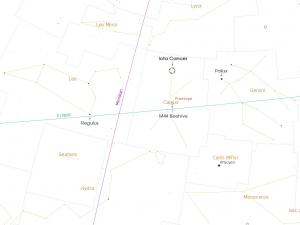Binary Star: Iota Cancer
During this month of April, light traveling across the galaxy for 329 years shines at us from the top of the dim constellation Cancer. This light originates from the binary star, Iota Cancer. This fantastic binary star, though tough to see naked eye from urban locations, is quite visible and beautiful using a small backyard telescope. On a clear night this month grab your telescope and set out after twilight to catch a glimpse of the mesmerizing binary awesomeness that Iota Cancer has in store.
Iota Cancer has a visible magnitude of 4.0 and lies 329.6 light years away. Made up of two stars, Iota Cancer displays a wide degree of separation at 31 arcseconds, and vibrant color differences. Iota Cancer A, the primary star, has a spectral classification of G7 making it a bright large yellow star. Iota Cancer B, the companion star, is the smaller of the two stars with a spectral classification of A3 showing us a striking blue hue.
Observing Iota Cancer is relatively strait forward as the star is almost directly overhead at sunset. If you are under relatively dark skies free of any major light pollution, you can find the rather dim constellation Cancer by identifying with the naked eye a blurry spot in the sky almost directly overhead when facing south after twilight between the bright star Regulus in Leo and Pollux in Gemini. This blurry spot is the M44 Beehive cluster and resides at the heart of Cancer (The Crab). Once M44 is identified (take a peak with your telescope, it is surely worth it) follow the sky 9° north from the visible center of M44. The brightest star you see will be Iota Cancer. Since Iota Cancer is a magnitude 4 star it will be dim among the brighter stars in the sky and will only be naked eye visible outside of urban viewing locations.
Be sure to take some time to view this beautiful binary star. When observing, do not hurry away from the eyepiece but take a moment to be mesmerized by this lesser known binary that has a reputation to rival the bright, beautiful Alberio binary in the summer sky.
Star Reference:
Right Ascension (J2000): 08h 46m 41.817s
Declination (J2000): +28° 45' 35.76"
Flamsteed: 48 Cancri
SAO: 80416
HIP: 43103
See attached finder chart
- Author:
- Scott MacNeill
- Entry Date:
- Apr 11, 2013
- Published Under:
- Scott MacNeill's Columns


